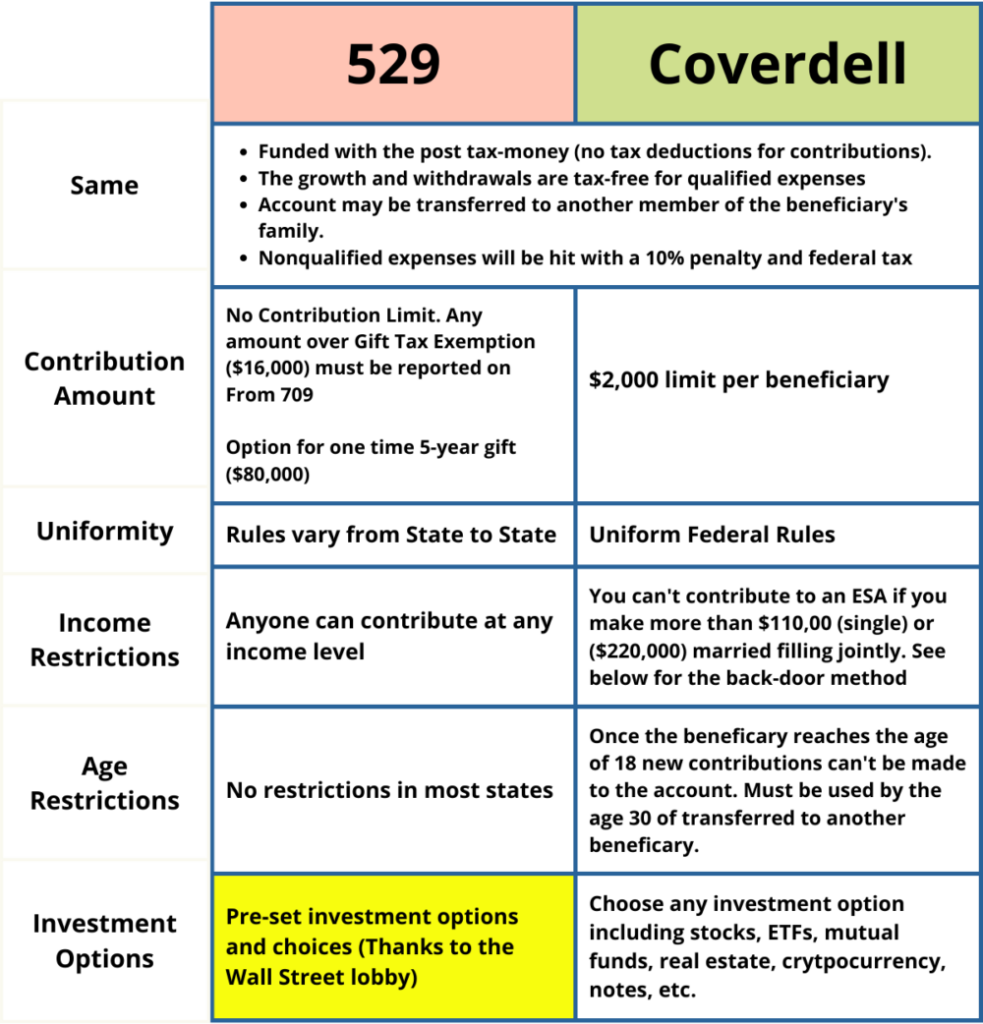The Coverdell ESA is far better than the 529 and the best tool to save and build wealth for college expenses tax-free. The problem is the Wall Street Lobby makes the 529 easier to contribute to and work with. This needs to change! In the meantime, know that the Coverdell employs a secret weapon that can build a nest egg for college faster than the 529. Investment accounts are crucial for your future, including a 401K. KKOS is currently providing a special for $100 off a 401K set up, click here to check it out.
I realize that my bold opinion may fly in the face of what you’ve heard from your tax professional or financial advisor. I will back up this opinion clearly and explain why the Coverdell is the “hidden gem” in the financial marketplace for college savings.
The Main Similarities/Differences of a 529 vs. a Coverdell ESA
What’s with the Name?
The account gets its name from primary champion in the U.S. Senate, Senator Paul Coverdell, a Republican from the State of Georgia. The name “Coverdell ESA” can be confusing as this tax-preferred structure has been referred to various names in the past. Since originally passed in 1997 it has been referred to as an Education Savings Account, a Coverdell account, and formerly known as an Educational IRA. IGNORE ALL THE OTHER NAMES… they’ve all been combined into one: the Coverdell ESA, which I will simply refer to throughout this article as a “Coverdell”.
Why the 529 is so Popular?
Essentially, the answer as to why 529s get so much more ‘press’ and special treatment is two words: Wall Street. The financial industry gets to trade and bury their insidious expensive fees in the 529 accounts. Which are almost impossible to pinpoint and calculate.
In order for Wall Street to encourage investment into 529 accounts, they’ve lobbied Congress and made them more attractive by:
- Allowing for massive contributions compared to the Coverdell (80k in one year compared to 2k)
- No income limitations on donors opening up accounts
- Flexible options in making changes to beneficiaries
Other than that, they are terrible! The reason being is that you have no control over the investments and you don’t know what fees you’re paying. Thereby you are letting the financial industry play with your money unchecked, which they love.
If you don’t like what I’m saying Wall Street, just allow for self-directed 529 accounts…I didn’t think so. We’ll keep trying to lobby Congress for what’s fair and allow investors to choose their own investments.
The Secret Weapon Inside the Coverdell
The little-known fact that can transform your Coverdell into a powerhouse for college savings is the fact you can self-direct the investments. You can invest in what YOU KNOW BEST…not the options spoon-fed to you by Wall Street and 529 sponsors. Proponents of the 529 Plan rarely acknowledge this, let alone mention it.
This is significant, if not life-changing because the average 529 ROR (Rate of Return) is well below 10% (on an annualized basis after expenses- what really matters). The Coverdell rate of return can be unlimited, with lower costs, and far more control.
EXAMPLE #1: Yes…cryptocurrency is down since this last year. Yet, if you would have invested your $2,000 Coverdell on May 1, 2020 in the Cryptocurrency Ripple- XRP, approximately one year later on April 29, 2021, it would have been worth $180,797 (a 9,039% Rate of Return)! Are you kidding me?! Yes, Cryptocurrency is clearly a risky investment and that’s not XRP’s value today. Nonetheless, this example simply shows the possibilities of what type of return you might experience. Again, something Wall Street isn’t going to tell you!
Investing in real estate, notes, cryptocurrency, a private company, gold, or individual stocks is literally IMPOSSIBLE in a 529 Plan. Although, the Coverdell can even use non-recourse debt (or leverage), to even make small investments that can pay out enormous rates of return and accelerate your college savings account quickly.
EXAMPLE #2: I’ve had countless clients set up their LLCs to own rental property with their children’s Coverdell account as a small owner in the LLC. Later when the property is sold and the LLC liquidated, all of the cash from the investment (attributed to the Coverdell’s ownership in the LLC) goes back to the Coverdell tax free to be used for college. The rates of return on rental real estate including the appreciation, cash-flow, and mortgage reduction is exponentially greater than that of a State’s financial industry supported 529 plan.
How does the Coverdell Education Account work?
Fundamentally, think of the Coverdell as a Roth IRA for educational expenses.
Like a Roth IRA, any investments inside the Coverdell will grow tax-free and all qualified education expenses come out tax-free. These distributions would include qualified elementary and secondary school expenses – Not just college expenses. (More below).
There are 3 key people to keep in mind in the creation and funding of the ESA
- Beneficiary. Must be under age 18 when the account is established. Typically they are a child or grandchild for whose benefit the account is established.
- Responsible Party. This is the person that decides where the account is invested and when to make valid distributions for educational expenses. If the Beneficiary doesn’t use all the money by age 30, the Responsible Individual can change the Beneficiary to a different family member.
- Donor/Contributor. This is the person, which doesn’t have to be a family member, that makes the contribution to the Coverdell ESA in any given year under the applicable rules.
Contributions on Behalf of a Beneficiary
Beneficiaries do not have to be related to the Depositor. Otherwise stated, a Beneficiary can be just a young person you want to benefit and help with their future college education. However, Beneficiaries must be under age 18 when the Coverdell is opened on their behalf. Along with that the contributions of $2,000 a year can only be made up until the date of their 18th birthday (not the year they turn 18).
Example #3: You just had a new baby and a friend of the family opens a Coverdell up for your child as a gift. They put in $1,000 for future education expenses. Now you want to open a different Coverdell account for your child in the same year. You can open a new account, but the TOTAL contribution for the beneficiary, per year, is $2,000. You could only put in $1,000 into the account and your child would then have (2) Coverdell accounts of a value of $1,000 each.
The maximum contribution in 2022 to a Coverdell is $2,000 per Beneficiary, and if a Beneficiary has multiple Coverdell accounts. The total contribution is still limited to $2,000 amongst all accounts (Keep in mind and don’t fret…the contribution limit is not a drawback as I will explain further below). Contributions can be made up until April 15th for the prior year.
Example #4: So if your child is 12 years old, it’s currently May 1, 2022 and their birthday is on July 15th, you would be able to contribute $12,000 between now and their 18th birthday. (Nothing for 2021, it’s after April 15th, 2022). You can deposit $2,000 for 2022 now, then $2,000 for 5 more years. (Keep in mind that is $2,000 in 2027 before July 15th and their 18th birthday). That may not sound like a lot with the current cost of a college education, but wait until I discuss the Secret Weapon within the ESA below.
Who may be the Grantor or Depositor
It’s important to understand who qualifies to make a ‘contribution’ into a Coverdell for a Beneficiary. This is because there are income limits on who the Depositor can be, more on this later. However, Depositors into a Coverdell could be any of the following individuals:
- Mom or Dad
- Grandma or Grandpa
- Aunt or Uncle
- Even the Beneficiary of the ESA themselves
- In fact anyone! They don’t have to be family. Just someone that wants to help the Beneficiary save for college.
Now the current ‘front door’ rule in 2022 is that no one with more than $110,000 (single) or $220,000 (married filing joint) of Adjusted Gross Income, can make a contribution into a Coverdell on someone’s behalf.
In spite of that, proponents of the 529 Plan like to also harp on the Coverdell income contribution limit, but again I consider it a non-issue. This is because there is a legitimate ‘back door’ method. Over the years when necessary for a client, we employ a simple ‘work around’ or ‘back door’ method in order to make contributions.
- First, keep in mind that the person ‘establishing’ or ‘opening’ the Coverdell, doesn’t have to be the Depositor. This is the ‘Responsible Individual’.
- Second, consider who the Depositor will be and have them move the money into the Coverdell. It’s also important to note that the Depositor doesn’t have to have earned income or a minimum level of income either to make a contribution.
Back Door Method Example: Mom and/or Dad can open the Coverdell account and control it as the “Responsible Individual”, but the Depositor can be someone else. Hence, this method is simply for Mom and/or Dad to gift money to a friend or family member (under applicable gifting rules and limits of course), and the recipient of the gift makes the deposit into the Coverdell on behalf of the Beneficiary. Simple, straightforward, allowed, and nothing wrong with that!
The Control of the Responsible Individual
This is a wonderful feature of the Coverdell because the Responsible Individual can be involved in the Coverdell right from the beginning and help make it happen at the forefront and carry it ultimately across the finish line when all the funds are distributed.
In practicality, the Responsible Individual is typically the one that ‘opens’ the ESA and coordinates the contribution. EVEN IF they aren’t the Donor to the ESA themselves due to an income limitation (see below).
Most importantly, the Responsible Individual can change the named ‘Beneficiary’ at any time! The only caveat is that the ‘roll-over’ or ‘transfer’ to a new beneficiary must be a qualified family member ‘in relationship to the original Beneficiary’, NOT the Responsible Individual OR the Donor/Contributor. To comply with the beneficiary change rules, the new beneficiary must be under age 30 and one of the following family members in relation to the current Beneficiary of the Coverdell before the change:
- Spouse
- Child or descendent of child, stepchild, or eligible foster child
- Brother, sister, stepbrother, or stepsister
- Father, mother, stepfather, or stepmother
- Aunt or uncle, niece or nephew
- Son-in-law, daughter-in-law, father-in-law, mother-in-law, brother-in-law, or sister-in-law
- Spouse of any person described above
- First cousin
Important Note During Formation: When the Coverdell is established, make sure on the formation documents to indicate that the Responsible Party will continue in this role after any Beneficiary turns 18. IF this election isn’t made, then the Beneficiary will assume control of the Coverdell at age 18 and can make any decisions they want regarding investments or distributions (giving them unfettered access to the ‘cookie jar’).
The Responsible Individual not only gets to control the investments of the account, but can also decide when to distribute funds for a valid expense. Let’s get real…we don’t want the Beneficiary to have access to the ‘cookie jar’ without oversite.
What are Qualified Education Expenses?
Essentially, this term means tuition, fees, books, supplies, and equipment required for study at any accredited college, university, or vocational school in the United States and at some foreign universities. However, the money can also be used for room and board, as long as the fund beneficiary is at least a half-time student.
Off-campus housing costs are covered up to the allowance for room and board that the college includes in its cost of attendance for federal financial-aid purposes.
Beneficiaries may withdraw the money tax-free for qualified elementary and secondary school expenses- Not just college expenses. This means you can pull money out tax-free for private elementary, middle, or high school.
Do I get a Tax Deduction for Contributing to the Coverdell?
There is no state or federal tax deduction to ‘contribute’ to the Coverdell, which is certainly a drawback compared to the 529. Most states allow for a State Tax Deduction for contributions to ‘their’ 529 plans. Although, donors receive NO Federal Tax Deduction.
Note, that a deduction can only be taken for the 529 in certain States where the donor is a resident of the same State where the Plan is established.
Why isn’t Wall Street on Board with the Coverdell?
One simple reason: Wall Street makes more money with 529 plans, has more control of YOUR money, and can charge excessive fees (compared to self-directing an ESA).
I seriously can’t calculate the amount of time I’ve wasted trying to find the actual Rate of Return (ROR) on any 529 Plan, AFTER expenses, set forth in a simple, straightforward manner, front and center on a 529 Plan’s website
Promoters or advocates of the 529, Wall Street banks, Brokerages, and Mutual Fund Managers, will load up their websites with
- performance rankings with other plans,
- how great their diversified plans are (when they offer only one mutual fund managing the plan),
- how their expense ratios relate to other plans, and
- ALL of this without disclosing an actual annualized rate of return after expenses.
The only way I’ve found to get to find the truth of the actual expenses and rates of return inside a 529 plan, is to decipher a one-inch thick prospectus and spend hours diving into the detailed reports of any given 529 Plan. If anyone reading this article has access to a web page simply summarizing the actual rates of return on 529 Plans across the country, I would truly welcome it and link it here to this article.
Coverdell ESAs + Roth Accounts!
The ‘next level’ strategy that we’ve implemented countless times clients. I use in my own personal business structure and portfolio, it is to combine the Coverdell and Roth accounts of family members in a multi-member LLC to invest in real estate and small business to get greater rates of return. There are options and NOT just what Wall Street is telling you!
Yet true, these types of structures are complex. They will certainly involve a consultation with one of our accountants or tax attorneys. If you’re not ready to make an appointment with one of our specialists, but want to start learning about the concept of self-directing ANY of your retirement accounts including your Coverdell ESA, please watch our “6th Semi-Annual Self-Directed IRA Summit” held just this past month in April of 2022.
This strategy would take several pages to explain in detail. I will simply explain it here in the form of “steps” with a sentence or two of explanation per each step.
Steps:
- Step 1. Create a Coverdell for each of your children, grandchildren, or nieces and nephews (the Beneficiaries). Make yourself the “Responsible Individual” and elect to continue serving as the Responsible Individual once they turn 18.
- Step 2. Have a person that falls within the income limitation fund each of these accounts. Use a “backdoor method” to contribute to the beneficiary’s account if the Responsible Individual has too high of an income.
- Step 3. Contribute $2,000 to each account for 2022. Each beneficiary can only have $2,000 contributed to an ESA on their behalf, no matter how many accounts.
- Step 4. Create a Roth IRA for each Beneficiary that you are also establishing a Coverdell. This requires that the Beneficiary has earned income up to the contribution amount, not to exceed $6,000. This is a multi-step procedure with lots of moving parts. For more details, see my article: “Paying Your Children in the Business- Young or Old”.
- Step 5. Combine Accounts. Combine the Coverdell ESA accounts and Roth IRA Accounts into one self-directed special purpose LLC (aka. IRA/LLC). This will allow you to pool funds to create a bigger account to use for projects and open up more. For more details, see my YouTube video: “What is an IRA LLC?”
- Step 6. Self-Direct On! Invest the LLC funds in what YOU KNOW best and that ultimately gets you the best rate of return.
- Step 7. Make Distributions. Distribute funds to the primary Beneficiary you designated in the beginning.
- Step 8. Change the Beneficiary. If the funds aren’t used entirely by your first Beneficiary before they turn 30, change to another Beneficiary/family member under age 30.
Conclusion
All in all, many a parents understand the seriousness and stress ‘college savings’ can place on a family. However, just like a retirement savings plan, the best strategy is to just start saving now. In my opinion, start self-directing your Coverdell as soon as possible to reap the highest possible rates of returns.
As a parent myself with 4 kids, and two of their spouses in college this year, I encourage you to take this seriously. Just start with a simple Coverdell account, and don’t give up. When considering a Coverdell ESA vs 529 plan, the Coverdell is simply hands down better than the 529…every time.
To learn more or open a self-directed Coverdell account visit Directed IRA’s Coverdell Account Page.








